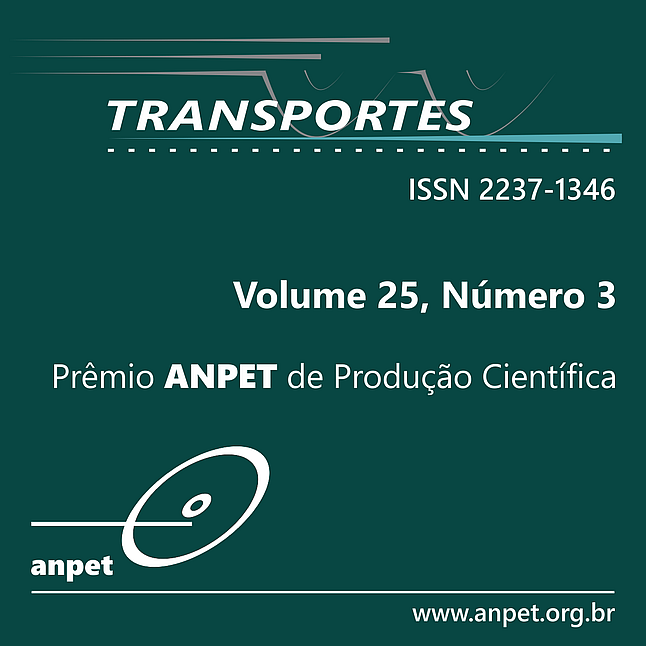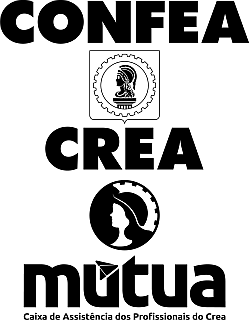Prevalência de fatores associados à severidade dos acidentes em entorno de escolas
DOI:
https://doi.org/10.14295/transportes.v25i3.1331Palavras-chave:
Estrutura urbana, Escola, Logit Ordenado, Logit multinomial, Segurança viária.Resumo
Promover a segurança viária nos entornos escolares é uma estratégia que contribui para que sejam construídas cidades seguras, saudáveis e sustentáveis. Este estudo é dedicado a identificar o conjunto de características físicas urbanas capazes de reduzir a severidade dos acidentes nesses entornos. A severidade foi analisada a partir das características da estrutura urbana, socioeconômicas, da instituição escolar e dos acidentes registrados (entre 2012 e 2014) no entorno de 905 escolas de Porto Alegre. Foram estimados modelos de escolha discreta ordenados e não ordenados, permitindo a comparação entre as abordagens. Entretanto, não foi identificada superioridade de uma abordagem metodológica sobre a outra. O conjunto de estimativas indica que a severidade dos acidentes no entorno escolar é influenciada por características da escola, do acidente, socioeconômicas e pela estrutura urbana, com destaque para influência negativa do número de interseções com quatro vias.7
Downloads
Referências
Abay, K. A. (2013) Examining pedestrian-injury severity using alternative disaggregate models. Research in Transportation Economics, v. 43, n. 1, p. 123-136. DOI: 10.1016/j.retrec.2012.12.002
Abdel-Aty, M.; S. Srinivas e C. Lee (2007) Geo-spatial and log-linear analysis of pedestrian and bicyclist crashes involving school-aged children. Journal of Safety Research, v. 38, p. 571–579. DOI: 10.1016/j.jsr.2007.04.006
Akaike H. (1992) Information Theory and an Extension of the Maximum Likelihood Principle. In: Kotz S. e N. L. Johnson (eds) Breakthroughs in Statistics. Springer Series in Statistics (Perspectives in Statistics). Springer, New York, NY. DOI: 10.1007/978-1-4612-0919-5_38
Andreou, M. (2010) Planning for Pedestrian Safety around Schools. 96 f. Trabalho de Diplomação. (Faculty of the Built Envi-ronment), University of New South Wales, Sydney, Austrália. 2010.
Ben-Akiva, M. e S. Lerman (1985) Discrete Choice Modeling: Theory and Applications to Travel Demand. MIT Press. Massa-chusetts. ISBN 0-262-02217-6
Bierlaire, M. (2003). Biogeme: A free package for the estimation of discrete choice models, Proceedings of the 3rd Swiss Trans-portation Research Conference, Ascona, Switzerland.
Billingsley, S.; A. Silverman; M. Adhikari; R. Clarke e M. Cutler (2015) Goals for change, partners for action goals for action. Fia Foundation, Annual Report 2015. Obtido de: <https://www.fiafoundation.org/media/203498/fiaf-annual-report-2015-spreads.pdf>. Acesso em 9 de julho de 2017.
Cervero, R. e K. Kockelman (1997) Travel demand and the 3Ds : density, design, diversity. Transportation Research Part C: Emerging Technologies, v. 2, n. 3, p. 199-219. DOI: 10.1016/S1361-9209(97)00009-6
Cervero, R; O. L. Sarmiento; E. Jacoby; L. F. Gomez e A. Neiman (2009) Influences of Built Environments on Walking and Cy-cling: Lessons from Bogotá. International Journal of Sustainable Transportation, v. 3, n. 4, p. 203-226. DOI: 10.1080/15568310802178314
Chen, P. e Q. Shen (2016) Built environment effects on cyclist injury severity in automobile-involved bicycle crashes. Accident Analysis and Prevention, v. 86, p. 239-246. DOI: 10.1016/j.aap.2015.11.002
Clifton, K. J. e K. Kreamer-Fults (2007) An examination of the environmental attributes associated with pedestrian-vehicular crashes near public schools. Accident Analysis and Prevention, v. 39, n. 4, p. 708–715.
Curtis, C.; C. Babb e D. Olaru (2015) Built environment and children’s travel to school. Transport Policy, v. 42, p. 21-33. DOI: 10.1016/j.tranpol.2015.04.003
DATASUS (2016) Obtido de: <http://tabnet.datasus.gov.br/cgi/deftohtm.exe?sim/cnv/> Acesso em 24/05/2016.
Eluru, N.; C. R. Bhat C. R. e D. A. Hensher (2008) A mixed generalized ordered response model for examining pedestrian and bicyclist injury severity level in traffic crashes. Accident Analysis and Prevention, v. 40, n. 3, p. 1033–1054. DOI:10.1016/j.aap.2007.11.010
Eluru, N. (2013) Evaluating alternate discrete choice frameworks for modeling ordinal discrete variables. Accident Analysis and Prevention. v. 55, p. 1–11. Washington, D.C., DOI: 10.1016/j.aap.2013.02.012
Elvik, R. e T. Vaa (2004) The handbook of road safety measures. Elsevier, Oxford, Inglaterra.
Elvik, R. (2006) Laws of accident causation. Accident Analysis and Prevention, v. 38, n. 4, p. 742-747. DOI: 10.1016/j.aap.2006.01.005
EPTC (2015) Conjunto de Dados. Datapoa. Empresa Pública de Transporte e Circulação. Disponível em: <http://datapoa.com.br/dataset?q=acidentes&sort=score+desc%2C+metadata_modified+desc> Acesso em 30 abril 2015.
Ewing, R. e R. Cervero (2010) Travel and the built environment: a meta-analysis. Journal of the American Planning Association. v. 76, n. 3, p. 265-294, 2010. DOI: 10.1080/01944361003766766
Ewing, R. e E. Dumbaugh (2009) The Built Environment and Traffic Safety: A Review of Empirical Evidence. Journal of Plan-ning Literature, v. 23, n. 4, p. 347-367. DOI: 10.1177/0885412209335553
Ewing, R.; R. A. Schieber e C. V. Zegeer (2003) Urban sprawl as a risk factor in motor vehicle occupant and pedestrian fatali-ties. American Journal of Public Health, v. 93, n. 9. p. 1541-1545.
Ferreira, S. e A. Couto (2012) Categorical Modeling to Evaluate Road Safety at the Planning Level. Journal of Transportation Safety & Security, v. 4, n. 4, p. 308–322. DOI: 10.1080/19439962.2012.679385.
Hair, J. F.; W. C. Black; B. J. Babin; R. E. Anderson e R. L. Tatham (2009). Análise multivariada de dados. Bookman Editora.
Hillman, M.; J. Adams e J. Whitelegg (1990) One false move: A Study of Children’s Independent Mobility. Policy Studies Insti-tute. London, UK.
Jensen, S. U. (2008) How to obtain a healthy journey to school. Transportation Research Part A: Policy and Practice, v. 42, n. 3, p. 475-486. DOI: 10.1016/j.tra.2007.12.001
Larrañaga, A. M. L.; L. I. Rizzi; J. Arellana; O. Stramb e H. B. B. Cybis (2014) The Influence of built environment and travel attitudes on walking: a case study of Porto Alegre, Brazil. International Journal of Sustainable Transportation. v. 10 n. 4, p. 332-342. DOI: 10.1080/15568318.2014.933986
Litman, T. e S. Fitzroy (2016) Safe Travels: Evaluating Mobility Management Traffic Safety Impacts. Victoria: Victoria Transport Policy Institute.
Mannering, F. L. e C. R. Bhat (2014) Analytic methods in accident research analytic methods in accident research: methodo-logical frontier and future directions. Analytic Methods in Accident Research. v. 1, p. 1–22. DOI: 10.1016/j.amar.2013.09.001
McFadden, D. (1974) The measurement of urban travel demand. Journal of Public Economics, v. 3, n. 4, p.303-328. DOI: 10.1016/0047-2727(74)90003-6
Noland, R. B. e M. A. Quddus (2005) Congestion and safety: A spatial analysis of London. Transportation Research Part A: Policy and Practice, v. 39, n. 2005, 737–754. DOI: 10.1016/j.tra.2005.02.022
Orenstein, M. R.; N. Gutierrez; T. M. Rice; J. F. Cooper e D. R. Ragland (2007) Safe Routes to School Safety and Mobility Analysis. California: California Departament of Transportation.
Ortúzar, J. de D. e L. G. Willumsen (2011) Modelling Transport. JohnWiley & Sons, Ltd. 4th ed.
Patricios, N. N. (2002) Urban design principles of the original neighbourhood concepts. Urban Morphology. v. 6, n. 1, p. 21-32. ISSN: 1027-4278
Peden, M.; K. Oyegbite; J. Ozanne-Smith; A. A. Hyder; C. Branche; A. F. Rahma; F. Rivara e K. Bartolomeos (2008) World report on child injury prevention. Genebra: World Health Organization.
Quddus, M. A.; R. B. Noland e C. C. Hoong (2002) An analysis of motorcycle injury and vehicle damage severity using ordered probit models. Journal of Safety Research, v. 33, n. 4, p. 445-462. DOI: 10.1016/S0022-4375(02)00051-8
Quddus, M. A.; C. Wang e S. G. Ison (2010) Road Traffic Congestion and Crash Severity: Econometric Analysis Using Ordered Response Models. Journal of Transportation Engineering, v. 136, n. 5, p. 424-435. DOI: 10.1061/(ASCE)TE.1943-5436.0000044
Rifaat, S. M., R. Tay e A. De Barros (2011) Effect of street pattern on the severity of crashes involving vulnerable road users. Accident Analysis and Prevention, v. 43, n. 1, p. 276–283. DOI:10.1016/j.aap.2010.08.024
Rothman, L. M. (2014) Child pedestrian-motor vehicle collisions and walking to school in the city of Toronto: The role of the built environment. 199 f. Tese (Ph.D), The Institute of Medical Science: University of Toronto. Toronto, Canada.
Rothman, L. M.; R. Buliung; T. To; C. Macarthur; A. Macpherson e A. Howard (2015) Associations between parents perception of traffic danger, the built environment and walking to school. Journal of Transport and
Health. v. 2, n. 3, p. 327–335. DOI: 10.1016/j.jth.2015.05.004
Train, K. E. (2009). Discrete choice methods with simulation. Cambridge University Press.
United Nations (2016) Goal 11: Make cities inclusive, safe, resilient and sustainable. Sustainable Development Goals: 17 Goals to transform our world. Obtido de: <http://www.un.org/sustainabledevelopment/cities/>. Acesso em 11 de maio de 2016.
VTPI (2016) Online TDM Encyclopedia. Canadá, 2014. Victoria: Victoria Transport Policy Institute. Disponível em: <http://www.vtpi.org/tdm/index.php>. Acesso em 24 de agosto de 2016.
Welle, B.; W. Li; C. Adriazola; R. King; M. Obelheiro; C. Sarmiento e Q. Liu (2015) Cities safer by design: guidance and examples to promote traffic safety through urban and street design. World Resources Institute. ISBN: 978-1-56973-866-5. Washington, DC, Estados Unidos.
Washington, S. P.; M. G. Karlaftis e F. L. Mannering (2003) Statistical and Econometric Methods for Transportation Data Analy-sis. Chapman & Hall/CR, Boca Raton, Florida.
WHO (2015) Relatório Global Sobre o Estado da Segurança Viária 2015. World Health Organization. Genebra, Suíça. Obtido de: <http://www.who.int/violence_injury_prevention/road_safety_status/2015/Summary_GSRRS2015_POR.pdf?ua=1>/. Acesso em 9 de julho de 2017.
Yasmin, S.; N. Eluru e S. V. Ukkusuri (2014) Alternative ordered response frameworks for examining pedestrian injury sever-ity in New York City. Journal of Transportation Safety and Security. v. 6, n. 4, p. 275-300. DOI: 10.1080/19439962.2013.839590
Ye, F. e D. Lord (2011) Investigation of effects of underreporting crash data on three commonly used traffic crash severity models: multinomial logit, ordered probit, and mixed logit. Transportation Research Record: Journal of the Transportation Research Board, n. 2241, Transportation Research Board of the National Academies, Washington, D.C., 2011. p. 51–58. DOI: 10.3141/2241-06
Ye, F. e D. Lord (2014) Comparing three commonly used crash severity models on sample size requirements: Multinomial logit, ordered probit and mixed logit models. Analytic Methods in Accident Research, v. 1, p. 72-85, DOI: 10.1016/j.amar.2013.03.001
Zahabi, S. A. H.; J. Strauss, K. Manaugh e L. F., Miranda-Moreno, L. F. (2011) Estimating Potential Effect of Speed Limits, Built Environment, and Other Factors on Severity of Pedestrian and Cyclist Injuries in Crashes. Transportation Research Record: Journal of the Transportation Research
Board, n. 2247, p. 81-90. DOI: 10.3141/2247-10.
Downloads
Publicado
Como Citar
Edição
Seção
Licença
Ao submeter um manuscrito para publicação neste periódico, todos os seus autores concordam, antecipada e irrestritamente, com os seguintes termos:
- Os autores mantém os direitos autorais e concedem à Transportes o direito de primeira publicação do manuscrito, sem nenhum ônus financeiro, e abrem mão de qualquer outra remuneração pela sua publicação pela ANPET.
- Ao ser publicado pela Transportes, o manuscrito fica automaticamente licenciado sob a Licença Creative Commons CC BY 4.0. Esta licença permite o seu compartilhamento com reconhecimento da autoria e da publicação inicial neste periódico.
- Os autores têm autorização para assumir contratos adicionais separadamente, para distribuição não exclusiva da versão do trabalho publicada neste periódico (por ex.: publicar em repositório institucional ou como capítulo de livro), com reconhecimento da publicação inicial na Transportes, desde que tal contrato não implique num endosso do conteúdo do manuscrito ou do novo veículo pela ANPET.
- Os autores têm permissão e são estimulados a publicar e distribuir seu manuscrito online (por ex.: em repositórios institucionais ou na sua página pessoal) depois de concluído o processo editorial. Como a Transportes é de acesso livre, os autores são estimulados a usar links para o DOI do artigo nesses casos.
- Os autores garantem ter obtido a devida autorização dos seus empregadores para a transferência dos direitos nos termos deste acordo, caso esses empregadores possuam algum direito autoral sobre o manuscrito. Além disso, os autores assumem toda e qualquer responsabilidade sobre possíveis infrações ao direito autoral desses empregadores, isentando a ANPET e a Transportes de toda e qualquer responsabilidade neste sentido.
- Os autores assumem toda responsabilidade sobre o conteúdo do manuscrito, incluindo as devidas e necessárias autorizações para divulgação de dados coletados e resultados obtidos, isentando a ANPET e a Transportes de toda e qualquer responsabilidade neste sentido.









